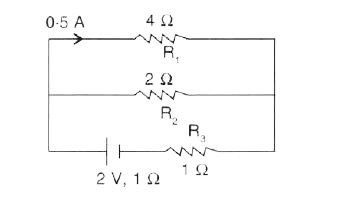How is the current flowing in a conductor changed if the resistance of conductor is doubled keeping the potential difference across it the same ?
The correct Answer is:Halved
To solve the problem of how the current flowing in a conductor changes when the resistance is doubled while keeping the potential difference constant, we can use Ohm's Law, which states:
V=I×R
where:
- V is the potential difference (voltage),
- I is the current,
- R is the resistance.
1. Understand Ohm's Law: According to Ohm's Law, the relationship between voltage, current, and resistance is given by the equation V=I×R.
2. Set up the initial conditions: Let the initial resistance be R1 and the initial current be I1. Therefore, we can write:
V=I1×R1
3. Consider the new conditions: If the resistance is doubled, the new resistance R2 can be expressed as:
R2=2×R1
4. Apply Ohm's Law to the new conditions: With the new resistance, the current I2 can be expressed as:
V=I2×R2
5. Equate the two expressions for voltage: Since the potential difference V remains the same, we can set the two equations equal to each other:
I1×R1=I2×(2×R1)
6. Simplify the equation: We can cancel R1 from both sides (assuming R1≠0):
I1=I2×2
7. Rearrange to find the relationship between I1 and I2: This gives us:
I2=I12
Conclusion:
When the resistance of the conductor is doubled while keeping the potential difference constant, the current flowing through the conductor becomes half of the initial current.
Final Answer:
If the resistance is doubled, the current becomes half of the initial current.
- V is the potential difference (voltage),
- I is the current,
- R is the resistance.
V=I1×R1
R2=2×R1
V=I2×R2
I1×R1=I2×(2×R1)
I1=I2×2
I2=I12
When the resistance of the conductor is doubled while keeping the potential difference constant, the current flowing through the conductor becomes half of the initial current.
If the resistance is doubled, the current becomes half of the initial current.
Topper's Solved these Questions
- CURRENT ELECTRICITYBook:ICSEChapter:CURRENT ELECTRICITYExercise:Exercise-9(B)Multiple choice
Explore 3 Videos
- CURRENT ELECTRICITYBook:ICSEChapter:CURRENT ELECTRICITYExercise:Exercise-9(B) Numericals
Explore 4 Videos
- CURRENT ELECTRICITYBook:ICSEChapter:CURRENT ELECTRICITYExercise:Exercise-9(A)Numericals
Explore 3 Videos
- ELECTRICITY AND MAGNETISM Book:ICSEChapter:ELECTRICITY AND MAGNETISM Exercise:TOPIC 2 Magnetism (4 Marks Questions )
Explore 6 Videos
Similar Questions
How does the mobility of electrons in a conductor change, if the potential difference applied across the conductor is doubled, keeping the length and temperature of the conductor constant ?
View SolutionHow does the mobility of electrons in a conductor change, if the p.d. applied across the conductor is doubled, keeping its length and temperature constant?
View SolutionRelation between current in a conductor and time is shown in fig.

If the resistance of the conductor is R, then the total heat disspipated across resistance R is
View SolutionWhen a current passes through a resistor, its temperature increases. Is it an adiabatic process?
View SolutionState the direction of the above currents in a conductor, stating which end of the conductor is at high potential.
View SolutionIn an electric circuit shown alongside, find

terminal voltage of the battery
View SolutionDetermine True or False. Electrons in a conductor have no motion in the absence of a potential difference across it.
View SolutionDetermine True or False. Electrons in a conductor have no motion in the absence of a potential difference across it.
View SolutionWhat is meant by electric circuit ? Why does electric current start flowing in a circuit the moment circuit is complete ? When do we say that the potential difference across a conductor in a circuit is 1 volt ?
Calculate the potential difference between the two terminals of a battery if 12 joules of work is done in transferring 2 coulombs of charge.
View SolutionName a device that helps to maintain a potential difference across a conductor.
View Solution

